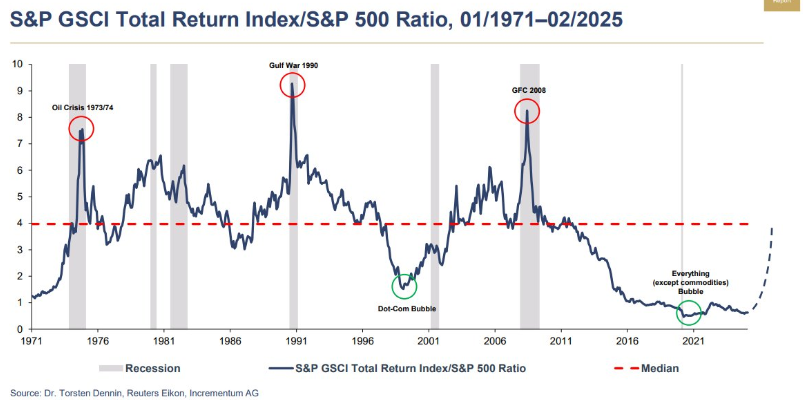This chart from Incrementum on X shows a very interesting long-term ratio: the Goldman Sachs Commodity Index (GSCI) Total Return divided by the S&P 500. Essentially, it tells you how commodities perform relative to equities over time. And across the last 50+ years, the chart shows three major cycles where commodities significantly outperformed equities:

1970–1976 – Oil crisis and rampant inflation pushed commodity prices higher.
Early 2000s to 2008 (GFC) – The China-led commodity supercycle with rising crude, metals, and agri prices.
Current Cycle (potentially starting now) – The ratio is again at historic lows.
The implication is that commodities are now at a relative bottom vs. equities, just as they were before each of the previous massive commodity upcycles.
What’s driving this view?
Excessive money printing over the last two decades has inflated asset classes like equities, housing, and Bitcoin.
Commodities, despite inflation, have barely moved. Crude oil, for example, is still around $70–$80 even after trillions of dollars have entered the system.
Gold, after consolidating around $2000 for years, seems to be breaking higher, potentially indicating a new re-pricing cycle.
Supply-chain disruptions, geopolitical instability, and the potential de-globalization trend are also structurally bullish for commodity prices.
The belief is that if another commodity supercycle is beginning, the rate of change in prices could be much steeper than equities, particularly if a global event triggers a liquidity push, similar to what happened during COVID or the 2008 crisis.
So what can investors do?
Direct commodity investing isn’t always feasible for all, but exposure to commodity-based stocks (like energy, metals, agri, and related sectors) is a practical alternative.
Gold exposure is critical, not just as a hedge against market volatility but also against monetary debasement.
While equities may continue to rise in nominal terms due to money supply growth, commodities may outperform in relative terms.
WeekendInvesting launches – Portfolio Momentum Report
Momentum Score: See what percentage of your portfolio is in high vs. low momentum stocks, giving you a snapshot of its performance and health.
Weightage Skew: Discover if certain stocks are dominating your portfolio, affecting its performance and risk balance.
Why it matters
Weak momentum stocks can limit your gains, while high momentum stocks improve capital allocation, enhancing your chances of superior performance.









